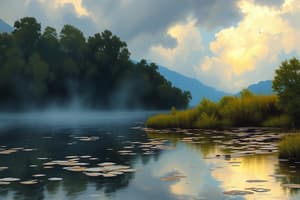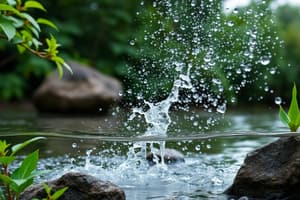Podcast
Questions and Answers
¿Cuál de los siguientes factores NO influye directamente en la distribución del agua en la Tierra?
¿Cuál de los siguientes factores NO influye directamente en la distribución del agua en la Tierra?
- La altitud
- La gravedad
- La evaporación
- La densidad de la población humana (correct)
El ciclo del agua se refiere a:
El ciclo del agua se refiere a:
- La formación de ríos y lagos
- El proceso de purificación del agua contaminada
- La cantidad total de agua dulce disponible en la Tierra
- El proceso continuo de evaporación, condensación y precipitación del agua (correct)
¿Cuál de las siguientes opciones NO es una clasificación común del agua?
¿Cuál de las siguientes opciones NO es una clasificación común del agua?
- Agua subterránea
- Agua salada
- Agua ácida (correct)
- Agua potable
El agua subterránea se caracteriza por:
El agua subterránea se caracteriza por:
La evaporación del agua es un proceso fundamental en el ciclo del agua porque:
La evaporación del agua es un proceso fundamental en el ciclo del agua porque:
Flashcards
Ciclo del agua
Ciclo del agua
Proceso natural de circulación del agua a través de la evaporación, condensación y precipitación.
Clasificación del agua
Clasificación del agua
Agrupación del agua basada en su uso, como agua potable, agrícola, e industrial.
Distribución del agua
Distribución del agua
Forma en la que se reparte el agua en la Tierra, incluyendo cuerpos de agua dulce y salada.
Evaporación
Evaporación
Signup and view all the flashcards
Precipitación
Precipitación
Signup and view all the flashcards
Study Notes
Agua: Uso, Manejo, Ciclos, Clasificación y Distribución
-
Ciclo del Agua: A process involving evaporation, condensation, precipitation, and runoff. Water constantly circulates between the atmosphere, land, and oceans. This continuous cycle is crucial for maintaining life on Earth.
-
Evaporation: Liquid water transforms into water vapor, primarily driven by solar radiation. Large bodies of water, such as oceans and lakes, contribute significantly to atmospheric moisture.
-
Condensation: Water vapor cools and changes back into liquid water, forming clouds. Cool air cannot hold as much water vapor as warm air.
-
Precipitation: Water released from clouds in the form of rain, snow, sleet, or hail, replenishing water sources on land and in bodies of water.
-
Runoff: Water that flows over the land surface into streams, rivers, and eventually back to the oceans or other water bodies.
-
Infiltration: Water that soaks into the ground, replenishing groundwater reservoirs.
-
Groundwater: Water held underground in aquifers, a vital source of freshwater for many communities and ecosystems.
Clasificación del Agua
-
Agua dulce: Water with low salt content, suitable for drinking and most human uses. Includes surface water (rivers, lakes, streams) and groundwater.
-
Agua salada: Water with high salt content, primarily found in oceans and seas. Not suitable for human consumption without treatment.
-
Agua superficial: Water found on the Earth's surface, such as rivers, lakes, and reservoirs.
-
Agua subterránea: Water found underground in aquifers and other porous rock formations.
-
Agua potable: Water safe for human consumption, meeting specific quality standards.
-
Agua residual: Water that has been used and may contain contaminants. Requires treatment before being discharged back into the environment.
Distribución del agua
-
Distribucion global: Uneven distribution of water resources globally.
-
Distribucion regional: Variations in water availability across different regions and countries. Some areas experience water scarcity, while others have excess water availability. This variability is influenced by climate patterns, topography, and human activities.
-
Distribucion temporal: Water availability can fluctuate with seasons; some regions experience floods during certain times of the year, while others face droughts.
-
Impacto del cambio climatico: Climate change is altering global water patterns, impacting the availability and distribution of freshwater resources.
Uso del agua
-
Usos domésticos: Water used for drinking, cooking, bathing, and sanitation. This use varies significantly based on cultural practices and economic conditions.
-
Usos industriales: Water used in manufacturing processes, cooling systems, and other industrial activities. Heavy industries often demand large quantities of water.
-
Usos agrícolas: Water used for irrigation, livestock, and crop production, often representing the largest sector in water consumption.
-
Usos recreativos: Water used for activities such as swimming, boating, and fishing.
Manejo del Agua
-
Conservación del agua: Techniques and strategies for reducing water consumption and waste.
-
Manejo sostenible del agua: Strategies for utilizing water resources in a way that meets the needs of the present without compromising the ability of future generations to meet their needs.
-
Reutilización del agua: Using treated wastewater for non-potable purposes, such as irrigation, toilet flushing, and industrial processes.
-
Infraestructuras de agua: Development of water infrastructure for efficient storage, transportation, and distribution, including dams, aqueducts, and pipelines.
-
Gestión integrada de recursos hídricos (GIRH): A holistic approach to water management that considers all uses and stakeholders. This approach aims to balance economic, social, and environmental needs.
Studying That Suits You
Use AI to generate personalized quizzes and flashcards to suit your learning preferences.




